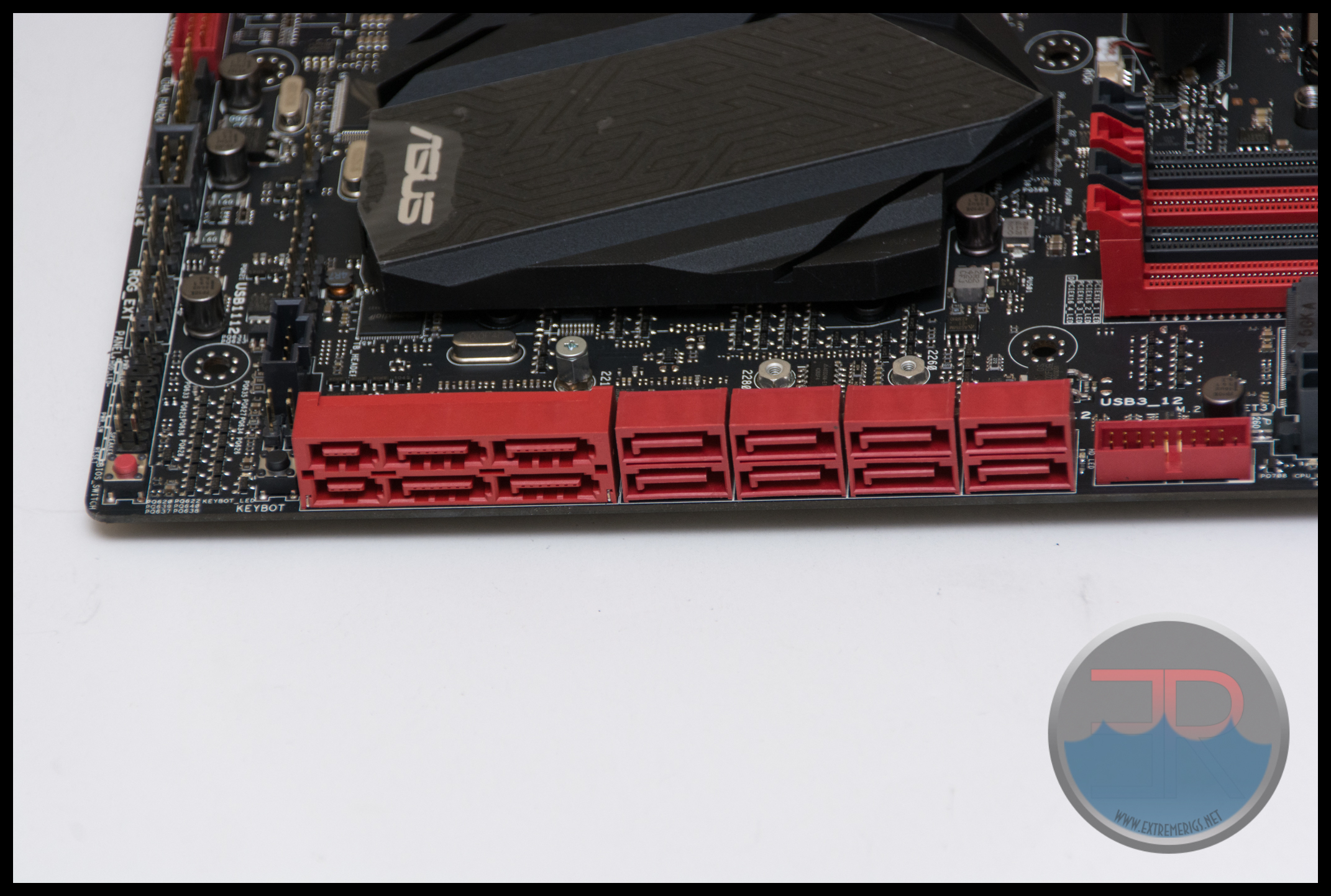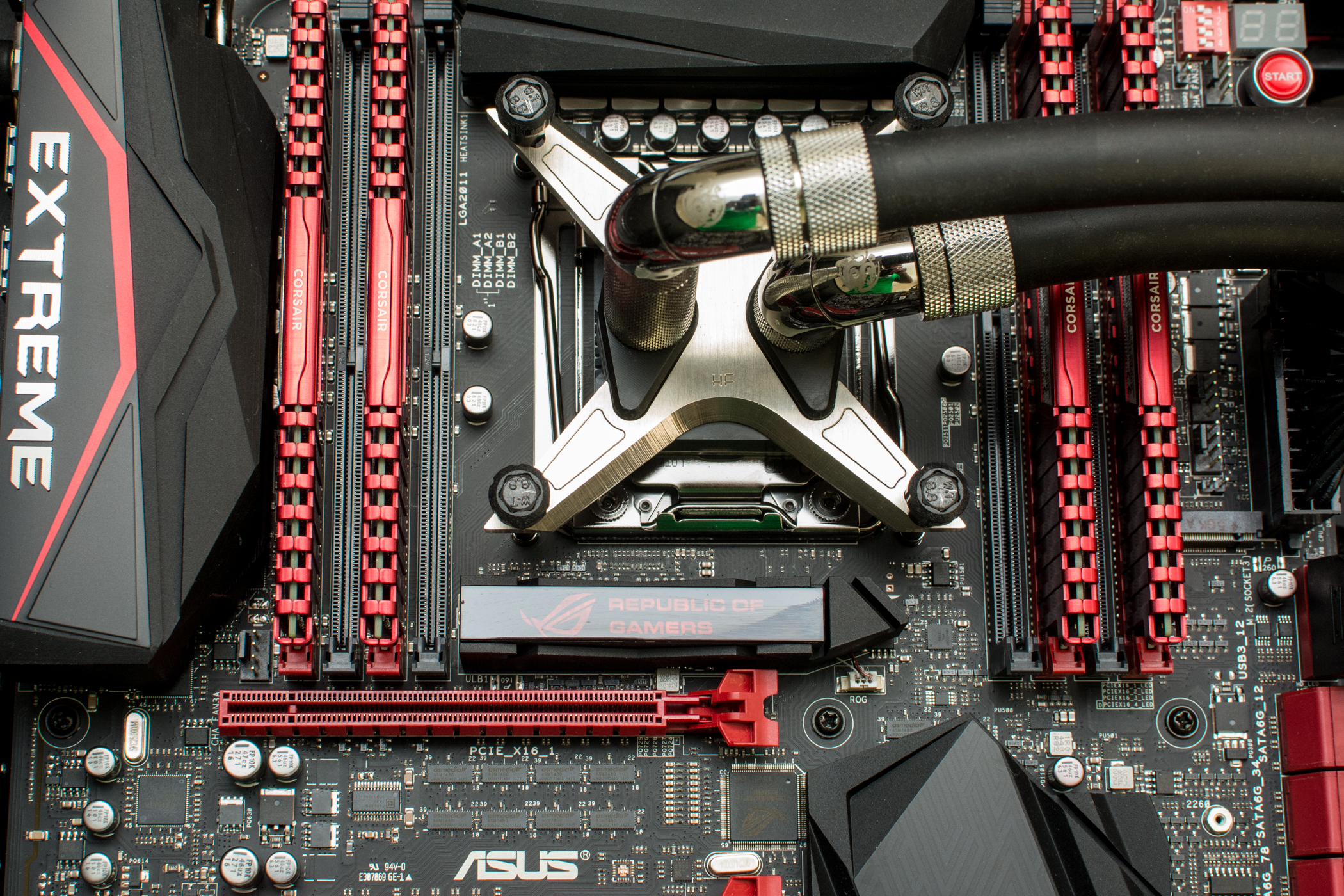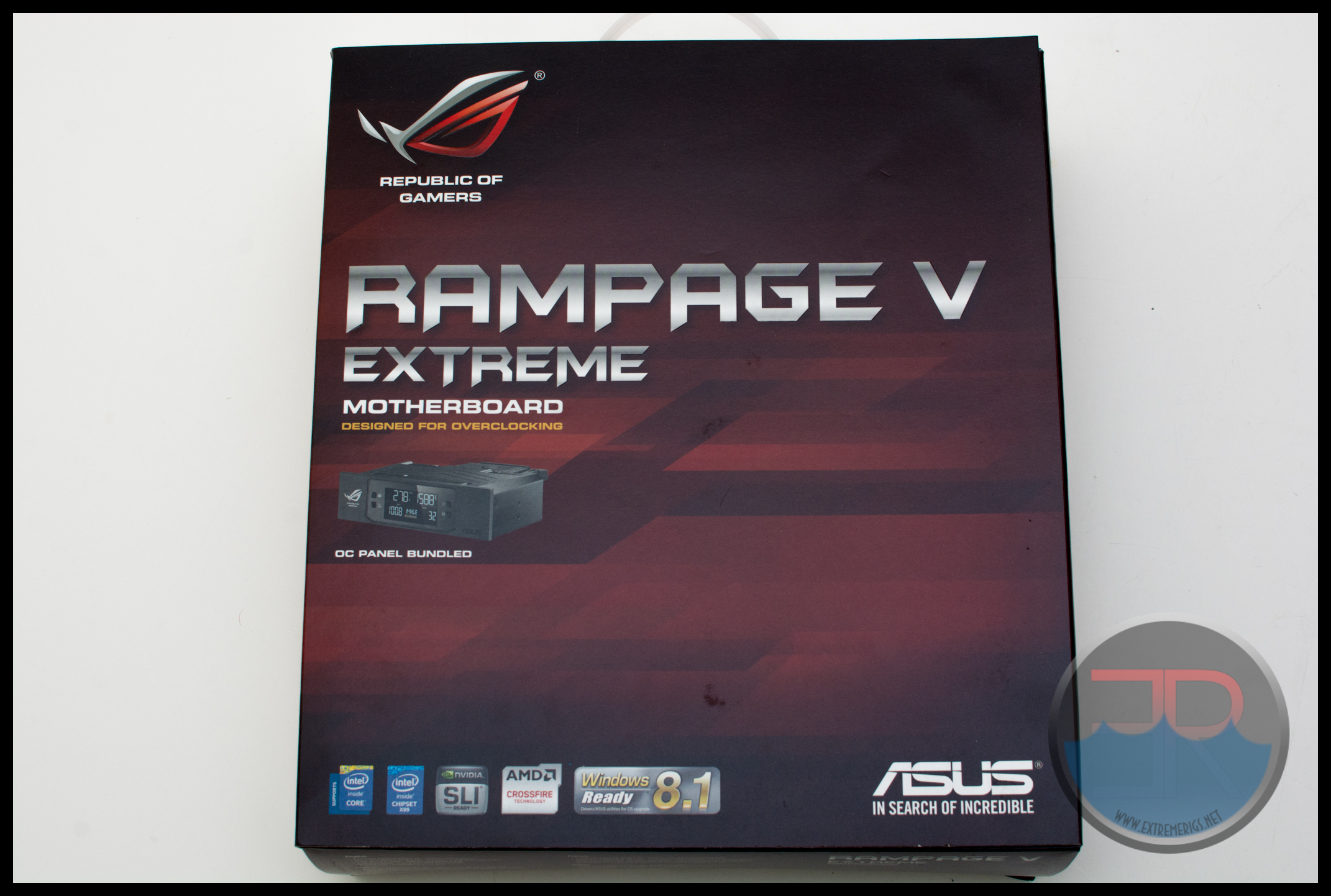Asus ROG Rampage V Extreme X99 Motherboard Review for Overclockers!
Oh yes. Oh yes. I don’t know even how to start this and express just how excited I am for this motherboard. Yes it’s been out for a few months but if you’re like me then despite loving new tech you’re also not usually willing to be a guinea pig and buy hardware in the first few months of release. This is particularly true when that tech is not cheap and requires things like 4 sticks of pricey new DDR4. Luckily Asus was kind enough to send us this beast for a detailed overclocking review so that gave us an excuse to suck it up and get with the program – so a big thanks to Asus Republic of Gamers!
So here we are 6 months after launch, and nearly three and a half years since the mighty X79 platform launched and we are still royally excited. But before we delve into the product let’s set the scene with a timeline of recent Intel chips. We are focusing on Intel simply because AMD has been absent from the high end enthusiast for quite some time now!
 So we can see that the “ultra enthusiast” market (two overclocked processors) has disappeared and the mainstream market has changed it’s motherboard chipset every other week. While all this has happened the “enthusiasts” have made much slower changes. X79 lasted three years and to be honest we are expecting X99 to last just as long.
So we can see that the “ultra enthusiast” market (two overclocked processors) has disappeared and the mainstream market has changed it’s motherboard chipset every other week. While all this has happened the “enthusiasts” have made much slower changes. X79 lasted three years and to be honest we are expecting X99 to last just as long.
There are some other lessons from history. The Rampage IV Extreme was hands down the most common board among enthusiasts. This is not so much based on sales figures as the impression as you trolled around enthusiast forums. Almost every high end build for three years used it. Mind you that’s not to say that the competition wasn’t slim. Both Gigabyte and EVGA managed to fudge their early release boards and while EVGA fixed this late in the day with the X79 Dark, Asus made sure to counter that with the Rampage IV Extreme Black Edition. While there was brief interest in the Asrock Xtreme 11 with it’s many pcie lanes there was no advantage to it for most users. Since then ROG also launched many high end mainstream boards on which to practice their new ideas and none of those were flops either. So, in short, expectations for this board are high. So before we get on to whether you should buy this X99 board let’s delve into what X99 brings to the table.
8 Real Stinking Overclockable Cores
Yes the i7-5960x finally gives us the fully unlocked 8 cores with hyperthreading that we’ve been dreaming off ever since we heard that X79 chips had 8 cores but only ever had 6 enabled. Now of course you may not want to pony up the stiff $900-1050 price for the 5960X. However if you don’t want to pay that much Intel have some interesting alternatives. The 5930K drops the price to $500-580 and cuts off 2 of those 8 cores. The 5820K drops the price further to $300-$380 and keeps the 6 cores but instead drops the pci express lanes from 40 down to 28. This really only means that the 5820K can not be used for quad GPU setups. But in our experience quad GPU rarely work that well and are almost never worth the cost. Yes we still build them though and so do some of you! The 5820K then is truly a bargain and a far better deal than the quad core 3820 and 4820K of the x79 generation. Having said this we know that if you’re reading ExtremeRigs then you will most likely still be buying the more expensive parts whether you need them or not.
Now if 8 cores aren’t enough there are server parts that may work that will have more cores. However you lose the advantage to overclock them much at all. At most a few percent on bclk and maybe the ability to keep turbo on all cores. So instead of a 4.5GHz 8 core 5960X and if you could find and afford one, you could try a E5-2699-V3 18 Core CPU which at stock runs 2.3-3.6GHz. If the software you run scales with cores more so than frequency then that would be really awesome.
DDR4
Ah yes DDR4 – X99 was the first chipset to support DDR4 at the enthusiast level and so at the launch of X99 DDR4 was in high demand. Thus prices were also high. The important thing to remember is that in the near future DDR4 will increase in size and speed significantly while dropping in price. The DDR4 that we see now will not really be representative of where things will stand in a year or two. Therfore I would recommend cheaping out for now. Besides which with a quad channel memory bus on X99 then memory bandwidth will already be significantly higher than the dual channel DDR3 on the competing mainstream Z97 chipset. An additional piece of useful information provided by Asus is that many CPUs can handle 4x4GB sticks at 3000MHZ CL15 DDR4, but beyond that many CPU memory controller’s struggle. Therefore spending $1000 bucks or more on some high speed kits may be a waste unless you are benching it! Having said all this now let’s look at what benefits ddr4 brings.
Frequency, Voltage, Timings and that DIMM socket change!
DDR4 is the 4th generation of double data rate synchronous dynamic ram. Synchronous means that a clock is used to control the bus cycles and latching in and outputting of the data. Dynamic means that the memory is not static – i.e. it needs power to constantly be refreshed or it “fades” away. Double Data Rate means that the data is latched in to a flip flop on the rising and falling edge of the clock. I.E. the clock does not have to be distributed on the motherboard at twice the data frequency making board design far easier! This is also why referring to DDR speeds in MT/s is correct and MHz is not. DDR4 is the fourth generation of DDR now so all of the above is par for the course. Let’s talk about what changes with DDR4.
At first glance there are some immediately obvious things – clock frequency is slightly higher for example, but that’s not all. While 2133MT/s is now the new 1066MT/s the “normal” operating voltage also changes – 1.2V is the new 1.5V. Timings change too – CL16 is the new CL9. One of the less mentioned aspects is also size because this is of most interest to servers – DDR4 increases the capacity per DIMM and adds more addressing capability to go with it. Now it’s doubtful whether you will see 128GB DIMMs for enthusiast use of course, but we do expect 8GB sticks to soon become the 4GB minimum of today with 16GB sticks being the high end but slower option. So what does all this mean for the memory “speed” which as enthusiasts is really what we care about?
When we are talking about memory “speed” we often really mean the end system level effect of the memory which is a combination of total memory bandwidth plus the latency or turnaround time on the bus. This is a factor of the clock frequency, architecture and all the different timings. Therefore there is no correlation to say X99 with DDR4 2400 CL15 would have the same memory “speed” as X79 with DDR3 2400 CL15. Effectively the higher bus frequency means that long reads and writes will be faster, but shorter ones may be a small amount slower due to the slightly higher latency. Overall the effect should be faster. Couple that with lower power from the reduced voltage and we see the usual progress that we expect from the IC industry!
So why did the socket change? For starters you wouldn’t want the same socket just so you don’t accidentally put the wrong type/voltage DIMM in the wrong slot. In addition signal termination has changed so that DDR4 unlike USB3 is not designed with backwards compatibility in mind. DDR4 also has more pins – some of them are for increased number of grounds – this helps with cross talk i.e. signal to noise ratio i.e. jitter i.e. it’s necessary to support the higher bus speeds. The other pins are because of the increased address space – DDR4 DIMMs can be larger and so more address lines are needed.
If you really want to delve into the details of DDR, we’d suggest reading up on DDR3 as a starting point with Rajinder Gill’s excellent article based on DDR3 over at anand. If you’re an engineer like myself you may also be interested in this detailed write up on DDR4 changes.
Sata Express
SSDs have had the single largest impact on compute in the last few years. Not only have they increased performance significantly but the experience of using a computer fundamentally has changed due to the lack of latency that HDDs had. SSDs have grown in size and become solidly mainstream while their prices have dropped such that mechanical drives are now dinosaurs. Why buy a mechanical drive at all when 1TB SSD can be had for less than $300 now? So with revenue comes R&D budgets. SSDs are still a new technology and so there is plenty of room for innovation and improvement. The fundamental speed limit is not the memory chips themselves which could run at over 16Gbps but the link between the CPU and those memory chips. This link consists of the PCI bus, the interface from PCI bus to SSD controller and the SSD controller itself. Sata Express attempts to replace the 6Gbps Sata III link as the new high bandwidth port that will touch the SSD controller itself. Sata Express essentially solves the problem by linking directly to the PCI Express lanes. With PCI Express 3 each lane is 8Gbps and you can have up to 16 lanes. Therefore even PCIE x2 or x4 would give a ton more bandwidth for new controllers with room to expand to more lanes if necessary. The early SATA Express controllers are however PCIE version 2 so that halves the amount of bandwidth per lane out of the gate.

The nice thing about SATA Express is it “partly” uses the same connector so that it can be backwards compatible. The SATA express connector consists of regular two SATA port connectors along with a third connector that looks like a slimmed down SATA. The two regular SATA connectors can be used as SATA connectors and the SATA Express mode only starts once all three are connected with a compatible drive. So why the drive towards faster SSDs anyway? Aren’t current SSDs much like quad channel memory “enough” for current usage? I have to admit to being guilty of that advice to many end users at times, but that’s often in the context of upgrading from mechanical drives where “any” SSD is a huge difference. The big jump this year is to 4K. While 4K displays were available last year even quite cheaply in the case of crappy TN screens we are finally getting quality IPS type screens at affordable prices. 4K video recording is now available on many cell phones and is starting to pop up on many consumer cameras too. With the launch of the NVidia Titan we also have a single GPU that can finally handle 4K/60 gaming. 4K means more data and that data will live on your SSD, whether you’re editing videos or playing games there are reasons that faster SSDs will be useful.
Another benefit of SATA Express is beyond just transfer speeds. SATAe adds NVMe support replacing AHCI. This cuts latency down significantly. In addition a higer queue depth means that your SSD is now using a protocol designed for SSDs rather than one designed for mechanical HDDs.
Whether or not you are looking to buy a SATA Express drive now, having it on the board makes it far more future proof. Given that the Rampage IV Extreme lasted three years, it’s hard to imagine that in 2 years SATAe drives won’t be as common as SATA is now. It should be noted that SATA Express is not part of X99 natively, instead it’s an after market add on that’s been put on some high end boards like the Rampage V Extreme. Asus chose to go with an Asmedia solution to enable this.
So there are many convincing reasons to jump to X99 – in fact the only reasons to not jump would be cost. If you have a 4930K based rig then you may also consider that the differences are too small to justify, but almost anyone else would see real benefits. Now that we know that X99 is exciting in general let’s take a look at the board itself!
















The Ultra has not dissapeared, see Asus Z10 D8 WS + E5-2699v3, it’s called Workstation.
Agreed, I was referring to systems that could overclock While “real” workstation users will use that workstation board happily my “idea” of ultra enthusiasts consist of people who won’t give up their overclocked performance but still want more cores and are willing to pay for 2P. Those same workstation users who prefer more cores might even be happy with a 4P after all. Since the SR2 there have been no real overclockable 2P chips.
While “real” workstation users will use that workstation board happily my “idea” of ultra enthusiasts consist of people who won’t give up their overclocked performance but still want more cores and are willing to pay for 2P. Those same workstation users who prefer more cores might even be happy with a 4P after all. Since the SR2 there have been no real overclockable 2P chips.
[…] Asus Republic of Gamers Rampage V Extreme X99 Motherboard Review for Overclockers! […]
Nice Review! Helped me a lot!
Can you tell me the name of the Waterblock in the top picture please? It looks so sick!
MIPS IceForce HF – MIPS closed down and I think AquaTuning bought all the remaining stock – so that might be your best for these if any remain!
Thank you very much!
[…] Asus Republic of Gamers Rampage V Extreme X99 Motherboard Review for Overclockers! […]
I think this board is too much oriented to the LN2 and TEC peoples. Of course we live under their umbrella so if ASUS covers those peoples, we are covered too. But sadly, most of us mortals won’t even use these hardware level (and few software level) features for WC builds, so don’t you think there should be lower-dog of ROG (probably R5 Formula) for X99? Or does Deluxe suffices?
I have to admit I’d rather see a Gene matx version before a formula. Yes for some the deluxe suffices for that role though
[…] Asus Republic of Gamers Rampage V Extreme X99 Motherboard Review for Overclockers! […]
Comments are closed.